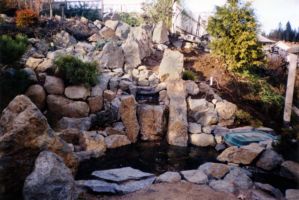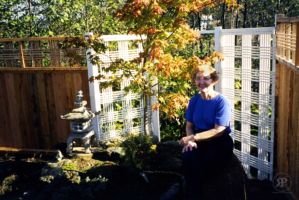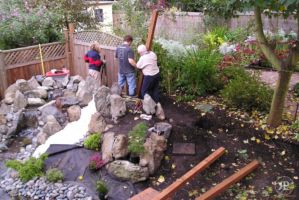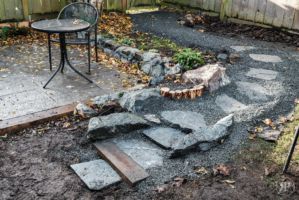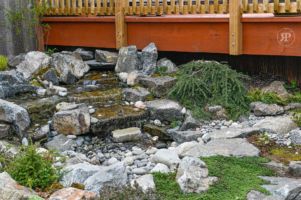.jpg)
Garden Gnome, 2017
“Where does the answer lie?
Living from day to day
If it’s something we can’t buy
There must be another way” ~ ”Spirits in the Material World,” from “Ghost in the Machine,” The Police
In another life, I was a gardener. Indeed my paternal great-grandfather was a park keeper in England, and serendipitously I discovered the origin of our family name from the back of a packet of Smith’s Crisps, in the fenced yard behind a girlfriend’s terraced house in Wolverhampton.
Today, there are apps for that, where I learn that Parker is the 892nd most common surname in the world, shared by approximately 587,414 people, most of whom I assume are not park wardens.
That’s a field, so to speak, I often felt a calling to, particularly during my climbing days. Alas, I did not feel a similar attraction to classrooms where I might have obtained the required degrees, which these days include things like “resource management,” communications, enforcement, contract and permit administration, as well as equipment operation and maintenance. There doesn’t appear to be any openings for a resident dreamer. I suspect the heyday of mountain poet/wardens like Sid Marty are past.
So this is my idea of gardening — the wild and the tamed, source of adventure and the lyrical, but not vegetables.
.jpg)
Joan. Granddad’s Garden, 1940s
Over the years, my horticultural and landscaping inspiration has come from the East, rather than the West. I have had a part in the design and construction of three (this latest small allotment will make 4) Japanese-style gardens. The reference to wilderness suits my inner-mountain troll, itself informed by great days spent in natural alpine “gardens.” For though I’ve never visited any of the Three Great Gardens of Japan, I have trod the stone stairways built by Lawrence Grassi (1890-1980) in the Rockies.
Not having the authority to tax my subjects and use indentured labour like the emperors of Edo, resources have come from family coffers.
By comparison to the paths of Yoho Park, or the 25-acre Kenroku-en of Kanazawa, the fruits of my labour are modest, but they pay homage to those monumental achievements, themselves inspired by sublime visions of nature.
And yet, among the greatest expressions of the material world, we are reminded that all things, even mountains, are transitory in the universal sense. Human notions of posterity are belied by the same antiquities we associate with permanence: dolmens, temples, and pyramids.
On my first return to England (after 23-years) I received a visceral reminder that all things must pass. Visiting my 92-year-old grandfather Parker’s home, a place bound with memory, I was eager to see the back garden, where I had crawled as a child among carnations, source of the fragrance that transports me still, and learned to walk along the central path between rows of runner beans and cabbage.
It was a gut-wrenching shock to see a mass of wild brambles where Eden once flourished, tended by my grandfather’s patient hands.
A couple of years ago, my wife and I made the mistake of visiting a house my parents owned 20-years-ago. The garden project there was a real family affair. Over a period of eight-years we turned a bare ¾-acre lot into a beautiful park worthy of a Better Homes & Gardens feature. Wildlife ponds connected by streams and waterfalls bisected three levels, contained by huge dry-stone retaining walls. Stone patios and steps meandered through trees and shrubs, including Asian pear, rhododendron, juniper, cedar, spruce, and a tanyosho pine that I trained in “windswept-style” beside the lower pond. Rescued from the “TLC“ section of a nursery, the sickly tanyosho had prospered under our care, developing a thick, scaly trunk and superb branch ramification.
We learned soon after the sale of the place that the new owners had hard-pruned the prize evergreen, expecting it to put out new growth like a deciduous tree.
But nothing could have prepared us for the sight that met us on that most recent visit: stilled ponds and stream courses filled with garbage; fences and Japanese-style trellis, hand-made by my parents, toppled among overgrown weeds, dead rats and dog faeces.
Dad, with whom I worked on so many beautiful gardens over the years, with that one as a crowning achievement of sorts, had recently died. It was a kick in the guts. We were so glad my bereaved mother, who had also applied her many skills inside and outside the house, was not with us to witness the spectacle of neglect and depravity. It seemed to me a general symbol of social decline.
From that rural property, Mom and Dad moved to a city lot in Victoria and we created another beautiful, albeit smaller oasis, again with a water feature. It seems that once we have completed a garden, it’s time to move on. Thankfully, the new owner there has maintained our creation.
I busy myself this winter (the season I prefer to work in) on a new project, slightly larger than the last, again with my favourite element as the skeleton, if you will, supporting the design. Unfortunately, my old bones and their supporting sinews, compromised by age and injury, no longer cope well with boulder wrestling. Consulting photos in the gallery above, it’s hard to believe we moved those monoliths … every one by hand. To think I am now the same age Dad was when we started that project!
At this point, it’s not clear if the old carcass is up to finishing the latest job, at least as envisioned. At the risk of Biblical reference, “the spirit is willing, but the flesh is weak.”
Photography is tangential to this story, other than as a snapshot record of gardens past and in progress and how both are tied up with family history.
Last year, on a visit to my native soil, in the throes of an emotional catharsis I was compelled to create the photograph below, in my brother- and sister-in-law’s garden.
On Saturday night, I made what might be the next in the series of garden ghosts. I apologize that there are no faeries, only this humbled gnome … hmmm ….
.jpg)
Garden Ghosts, Kent, England, 2016






















